
When you're pregnant, your baby changes every day, and your body has to keep up. How is the pregnancy progressing, week after week, month after month? Read our guide to better understand your and your baby's journey.
Pregnancy by weeks and months - Evolution of pregnancy
For starters, pregnancy is nine months long, divided into three different trimesters:
Quarter 1 - weeks 1 - 13
Quarter 2 - weeks 14 - 27
Trimester 3 - weeks 28 - 40
Weeks of pregnancy are counted from the first day of the last period. Moreover, in the first trimester you will go through rapid and not very visible transformations of your hormones.
First trimester of pregnancy
The first trimester begins with the first 2 weeks when you are not yet pregnant: it is the period of ovulation! The first sign of pregnancy in these weeks is the lack of menstruation, but you may not know that you are pregnant. Read HERE more about how you realize you are pregnant and what are the first signs of pregnancy. Discover HERE everything you need to know about sex during pregnancy and the recommended positions for your comfort and the safety of the baby.
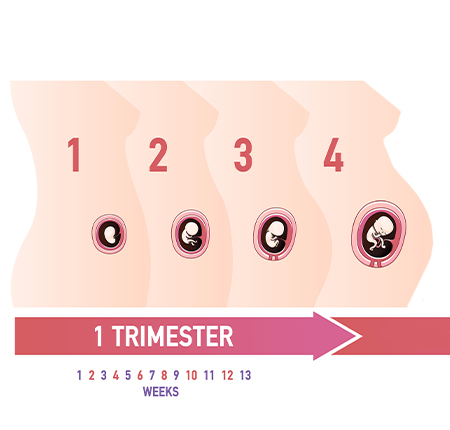
Week 1 of pregnancy
This is the week when if you want to get pregnant, you are super attentive to the first signs and buy test after pregnancy test. However, most women do not have any symptoms during this period because the pregnancy practically does not exist yet.
Implantation takes place only a week later, 10-14 days after conception, respectively after unprotected sexual contact. Also, pregnancy tests detect the hormone hCG only about 10 days after conception, when the fertilized egg is implanted and the pregnancy is fixed. So in the first week, you still don't really know you're pregnant, and you don't really have a way to confirm it.
However, there are women who report mild abdominal cramps, breast tenderness, and constant fatigue during the first 5-6 days after conception.
Week 2 of pregnancy
In the second week, the first symptoms may already appear. You notice that your period is late , you feel more tired, maybe you've even seen a few splashes of blood or pinkish discharge on your underwear (or on your daily pad, if you wear one).
It is implantation bleeding, which occurs approximately 10-14 days after conception. It happens because the fertilized egg now attaches itself to the lining of the uterus, which can damage the blood vessels in the uterine walls and cause light, short-term bleeding. If you notice heavier bleeding or at another stage of pregnancy, discover HERE what other causes there may be and when it is appropriate to talk to the doctor.
Right now, starting on day 10, you can start taking the first pregnancy tests to confirm if you will have a baby. Once the test is positive, you can already schedule the first visit to the gynecologist.
Week 3 of pregnancy
Three weeks after the first day of the last period, the fertilized egg descends into the uterus. During this period, you may have the following symptoms:
Nausea of pregnancy
Tender or enlarged breasts
The need to urinate more often
Food cravings
Fatigue
You feel dizzy
Week 4 of pregnancy
In week 4 of pregnancy, your body begins to form the placenta and amniotic sac.
So you may experience symptoms like: abdominal pressure and tender breasts, and as the cluster of cells that will soon become your baby embeds itself into the lining of your uterus, you may also notice some implantation bleeding – although this doesn't always happen.
Despite its extremely small size - no longer than 1 millimeter and no larger than a poppy seed - your little embryo is developing day by day. Visiting the gynecologist is essential!
Week 5 of pregnancy
In the 5th week, you have moved into the second month of pregnancy. This week, you can officially take a pregnancy test - because the hCG hormone level is high enough to show a positive result. And the pregnancy test is the surest way to find out if you are pregnant - you can read more about the first pregnancy test in our article .
Week 6 of pregnancy
This week, the embryo is the size of a pea -- the little one's head is starting to take shape, and the cheeks, chin and jaws are starting to form.
Your body's symptoms in week 6 may include heartburn, nausea, and frequent urination. Moreover, the pregnancy hormone hCG causes an increase in blood flow to the pelvic area, which can give you increased sexual pleasure.
Week 7 of pregnancy
In the 7th week of pregnancy, arms and legs begin to develop, as does the baby's head, as the mouth and tongue appear. Although the pregnancy is not yet visible on the outside – at 7 weeks you cannot see that you are pregnant, you can still have symptoms such as nausea, breast pain, frequent urination, excess saliva, indigestion and fatigue.
Week 8 of pregnancy
During this week, your baby is growing by about a millimeter a day, and not just in height: there may be sudden growth in arms, legs, back and other parts of the body.
At the level of your body, headaches, excess vaginal secretions and constipation can appear - in addition to the ones you are already used to!
Week 9 of pregnancy
Your baby is the size of an olive! And you can feel exhausted! It's too early to feel any movement, but his muscles are getting stronger by the day. Also, the period of the embryo ends and it now becomes a fetus! You are in your 3rd month of pregnancy. Fatigue persists, as does indigestion, cravings, increased frequency of urination, and bloating or constipation may occur.
Week 10 of pregnancy
You're three months pregnant, and your baby has officially transitioned from embryo to fetus. It is possible that at 10 weeks pregnant it will start to show (although it is normal not to see it) and you may also notice visible veins and increased vaginal discharge.
This week you may be extremely sensitive to smells and dizziness may occur. Talk to your doctor about remedies for nausea.
Week 11 of pregnancy
By week 11 of pregnancy, your baby has developed distinct human characteristics, including fingers and toes! But it's no bigger than a strawberry. Although the sex can't be determined yet, if you're having a girl, her ovaries will be forming this week!
As for your body, progesterone plays tricks on you: while it does a great job of maintaining a healthy pregnancy, you can feel constantly bloated, which isn't very pleasant. The scientific explanation for the gas you have now is that progesterone slows down your digestion to give more time for the nutrients in food to reach your baby!
Week 12 of pregnancy
Although it's hard to believe, the fetus has doubled in size in the last three weeks! And in the 12th week, he/she takes a huge step: his/her digestive system starts working and it's the first time you'll be able to hear his/her heart beat!
As you near the end of your first trimester, your uterus, now the size of a large grapefruit, begins to migrate from the bottom of your pelvis to a front and center position in your abdomen. You may get rid of the constant need to urinate, and other symptoms may improve: nausea, tender breasts, food aversions, and fatigue.
It's important to take care of your health: it's the right time to supplement vitamin C for more collagen and don't forget about hand hygiene: because your immune system is lower now than usual, which can make you prone to infections.
Week 13 of pregnancy
Hydrate yourself properly! It is very important to drink enough water. At the same time, you can do Kegel exercises (which I wrote more about here . Because childbirth is demanding not only on you, but also on your pelvic muscles - which have to stretch to previously unimaginable proportions! So, Kegel exercises helps to recover faster after childbirth.
2nd trimester of pregnancy
Welcome to the second semester of pregnancy! Every pregnant woman's favorite, and rightly so! As many of the discomforts of the first trimester lessen or disappear, you can now feel more at ease. Your energy level also comes back and your breasts are not so sensitive anymore. Other good news: you have less morning sickness and fewer trips to the bathroom to pee.
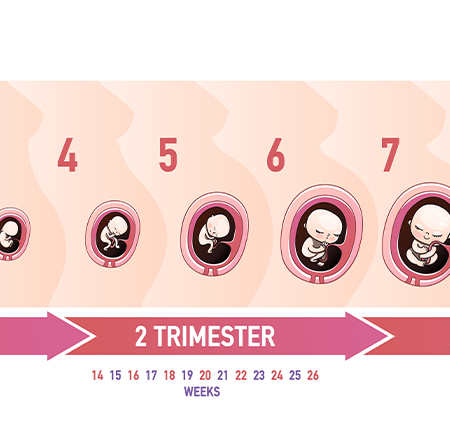
Week 14 of pregnancy
So, at 14 weeks, an expectant mother can feel more energetic but also with a stronger appetite! During this week, the baby's eyelids are glued to the fully developed eyes. Your baby may cry now because he has vocal cords. He may even start sucking his thumb. Fingers and toes will have nails.
Week 15 of pregnancy
The fetus begins to look more and more like a baby. Now that you have got rid of the symptoms of nausea, you can visit the dentist, because it is possible that problems caused by the pregnancy will appear: you can notice redness and inflamed gums, and it is not unusual! If your gums are more sensitive these days, it's because of hormones.
Week 16 of pregnancy
Baby is growing at a faster pace this week, and you might need some maternity clothes! Now, your uterus is growing with the baby—rather quickly—so the pregnancy will show well.
Week 17 of pregnancy
At week 17, your baby is practicing. Now learn how to suck and swallow! In fact, they are now developing vital, survival reflexes.
Week 18 of pregnancy
Your baby's nervous system is developing in the 18th week. A network of nerves is covered by a substance - myelin - which favors the transmission of messages from one nerve cell to another. He will now have senses: touch, smell, taste, sight and hearing!
Week 19 of pregnancy
In week 19, leg cramps may appear and cause you discomfort. There are some painful spasms that you can feel in the second and third trimester.
Week 20 of pregnancy
The fetus is now about 21 cm long. The ears are fully functional and can hear muffled sounds from the outside world. Fingertips have fingerprints. Genital organs can now be distinguished with an ultrasound! So, if you want to find out the sex of your baby, you can do it in the 20th week!
Week 21 of pregnancy
Your body will undergo changes at 21 weeks, and stretch marks will appear, as the skin begins to stretch - on the abdomen, bottom, thighs, hips and breasts. You will have more appetite and your nails will grow faster. It is recommended to rest more but not to skip daily walks.
Week 22 of pregnancy
If you are 22 weeks pregnant, you are in your 5th month of pregnancy! Only 4 months left! Your uterus is now about 2.5cm above your belly button - growing by leaps and bounds. Symptoms this week may include heartburn, cramps, stretch marks and dizziness. Magnesium supplements may help, but talk to your doctor!
Week 23 of pregnancy
Although at 23 weeks pregnant your baby's organs and bones are visible through the skin, it will become less transparent once the fat deposits that are now growing settle down!
Week 24 of pregnancy
In the 24th week of pregnancy you might feel your wrists and fingers numb. Well, chances are it's carpal tunnel syndrome.
Week 25 of pregnancy
Blood vessels also develop in your baby's lungs, bringing him one step closer to his first breath of fresh air. But at 25 weeks pregnant, those lungs are still developing.
During this week, more than half of pregnant women experience hemorrhoids due to the pressure exerted by the larger uterus, as well as the increase in blood flow to the area. And although they are not dangerous to the body, hemorrhoids can be downright painful and can even cause bleeding.
Week 26 of pregnancy
Your baby's eyes may open this week. And in terms of symptoms, you may struggle more with pregnancy insomnia and clumsiness as your belly continues to grow.
Week 27 of pregnancy
The baby can hear you, but you need to know that he will not hear clearly, because the ears are still covered by a protective layer of wax. Your baby may also have hiccups, so if you feel unusual movements in your tummy, it may be hiccups!
3rd trimester of pregnancy
You're 7 months pregnant, and in this trimester, your baby begins to experience REM (rapid eye movement) sleep, which means your little one is very likely to be dreaming!
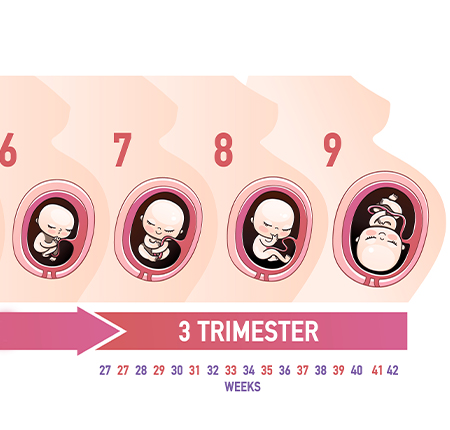
Week 28 of pregnancy
This week, your skin may be more sensitive. Some parts of the body may be dry and flaky, others with breakouts caused by heat or an external irritant such as body lotion or face cream.
Week 29 of pregnancy
At 29 weeks pregnant, your baby now weighs 1 kg and is between 15 and 16 centimeters long. Although he is getting pretty close to his birth length, he still has some weight to grow. In fact, over the next 11 weeks, he will double - or even nearly triple - his weight.
Week 30 of pregnancy
The increasing size of the belly is a clear indication that your baby is growing day by day. He will continue to gain about a pound a week for the next seven weeks.
Many of the early pregnancy symptoms you thought you had left behind may return: the need to urinate all the time, tender breasts preparing for milk production, fatigue and heartburn.
Week 31 of pregnancy
Your baby's brain is becoming more sophisticated and active than ever - pedaling, thumb sucking and other important real-world skills.
Week 32 of pregnancy
This week, your body might start preparing for the day of birth by flexing its muscles...literally. If you feel your uterus tightening or tightening periodically, these are Braxton Hicks contractions - irregular training contractions that are first felt around mid-pregnancy and increase in frequency.
They will stop if you change your position, so try to stand up if you're lying down or walk if you're sitting down.
Week 33 of pregnancy
With hormonal changes, midnight bathroom runs, leg cramps, heartburn, and a basketball-sized belly, it's no wonder sleep is elusive. Third-trimester insomnia affects about 3 in 4 pregnant women — who may also be dealing with anxiety about the upcoming birth and an up-night mind racing over the to-do list before the baby arrives. Take care of yourself this week!
Week 34 of pregnancy
If your baby is a boy, then this week the testicles are making their way from the abdomen to the scrotum.
Your body's symptoms are the usual: back pain, cramps, hemorrhoids, swollen legs, stretch marks, and insomnia.
Week 35 of pregnancy
Now that your baby is head down in preparation for birth, his head is pressing directly against your bladder. What is the result? Frequent need and urinary incontinence!
Week 36 of pregnancy
Welcome to week 36 of your pregnancy - officially the start of month 9. It can be hard to get around these days. To ease the discomfort, relax, do some pelvic exercises, take warm baths, apply warm compresses, get a prenatal massage from a certified therapist, or try some complementary and alternative therapies.
Week 37 of pregnancy
At 37 weeks pregnant, your baby is still growing. At this age, the fetus weighs around 2.5 kilograms. It stretches and moves because it's a little cramped in your uterus, so it may not hit as much.
Week 38 of pregnancy
In these last weeks, the baby swallows amniotic fluid, some of which ends up in the intestines, where - along with other cells - it will turn into the baby's first stool. The lungs are still maturing.
Most of the other changes this week are small but important: He continues to add fat and fine-tune his brain and nervous system - so he will be able to handle all external stimuli.
Week 39 of pregnancy
At week 39, you may feel uncomfortable. Your pelvis is feeling more and more sore and your Braxton Hicks contractions are getting stronger and more frequent - and that's a good thing, because it means your body is getting ready for the big event.
Watch for signs of labor. These include:
Rupture of the membranes containing the amniotic fluid (also known as water breaking)
Diarrhea or nausea, which many women experience even before labor begins
Power packs, also known as the nesting instinct
Loss of the mucus plug, which is the "plug" of mucus that seals the opening of the uterus
Blood, which occurs when your capillaries break due to dilation and rupture of the cervix, causing any discharge to appear pink or red.
Week 40 of pregnancy
At 40 weeks, you are officially at the end of your pregnancy. The placenta is still providing the baby with the antibodies it will need to fight infections in the first six months of life.
When will your body know it's time to give birth? Just because you have a date that the doctor predicted, doesn't mean Mother Nature will honor it. About 30% of all pregnancies last longer than 40 weeks.
One thing you can be pretty sure of if your water breaks before contractions start: labor will start within 24 hours. How can you tell if the amniotic sac has ruptured? Amniotic fluid is usually colorless and odorless. Another test: You can try to stop the flow of fluid by tightening your pelvic muscles (Kegel exercises). If the flow stops, it's urine. If it doesn't stop, it's amniotic fluid.
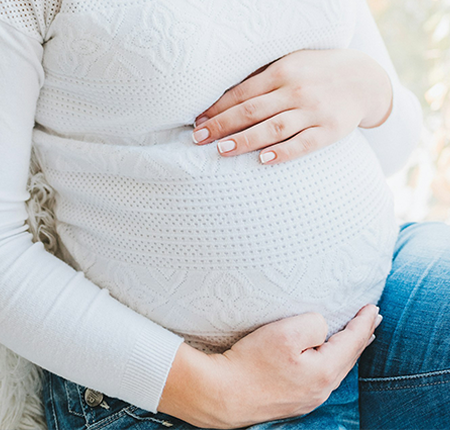
Over-term pregnancy
Less than 5% of babies are born on their due date and about 10% decide to stay longer in the womb. Also, most of the time a late baby isn't late at all - it's just that the due date was approximated and miscalculated - which is very common.
Week 41 of pregnancy
Meanwhile, your body is preparing for birth. By the time you're 41 weeks pregnant, your doctor has probably talked to you about inducing labor, but that doesn't mean you won't go into labor on your own; some babies need to take their time.
Week 42 of pregnancy
You have officially reached the end of your pregnancy. Your baby will likely undergo additional monitoring and in the meantime, your doctor may recommend induction of labour.
A pre-labor sign to be aware of may be mild diarrhea. It's your body's way of doing a natural enema to empty your bowels and make more room for the baby to pass through the birth canal.
Now, it's not much longer and you'll be holding your baby. You will begin the postpartum period, when the body will recover and, soon enough, you will receive the doctor's approval to resume sex life .
Pregnant belly by weeks
As pregnancy progresses, the mother's belly changes shape, size and appearance. There is a myth that the sex of the fetus can be determined based on these changes, but the truth is that the way a pregnant woman's belly looks depends more on the mother's body than on the baby developing there.
Among the factors that influence the appearance of the belly are the shape and structure of the mother's body, muscle tone, height, nutrition, but also the number of previous pregnancies. On the other hand, there are some universal changes that most pregnant women can expect. So here's what your tummy will probably look like at each stage:
Pregnant belly in the first trimester
It is very important to add images with the evolution of the belly over time and to make comparisons (eg: in the first 3 weeks of pregnancy, the size of the fetus is the size of an egg, 6-7 the size of an avocado)
During the first 3 weeks of pregnancy, the embryo is barely fixed in the uterine walls. The pregnancy is not yet visible and the belly does not change. Moreover, throughout the first trimester, the pregnancy is not yet visible in some women, and at most a rounding of the belly caused by bloating is seen. If your uterus is about the size of an orange before pregnancy, it generally grows to the size of a grapefruit by the end of the 1st trimester.
However, starting from week 4 and up to week 40, the changes will be more and more noticeable from week to week. Thus:
- During weeks 4-6, your belly may swell slightly and give you a bloated feeling. The baby grows from the size of a seed to that of a peppercorn.
- In weeks 7-9, your belly looks the same. The fetus reaches the size of a cherry.
- In week 10, especially if you are not in your first pregnancy or if you are expecting twins/triplets, you may notice that your belly is rounding. But still the pregnancy is still not very visible.
- In weeks 11-13, the uterus begins to expand over the pubic bone and the body prepares to begin the 3rd trimester of pregnancy. During these three weeks, the size of the fetus will increase from that of a fig to that of a lemon.
Pregnant belly in the second trimester
From week 14 until week 27, you will start to feel more comfortable and the pregnancy will be more and more visible. Towards the end of the 2nd trimester, the uterus will already be the size of a basketball, and the belly will look just as round.
At week 14, the belly is visible and the baby is the size of a peach.
In weeks 15-17, it's a good idea to start shopping for "mommy clothes" because the baby grows from the size of an apple to that of an avocado.
Starting from weeks 18-19, you will steadily gain weight and your belly will become more and more visible. If you're concerned about sudden weight gain, tell your doctor to make sure it's not a sign of a more serious problem.
At weeks 20-21, your uterus is roughly in line with your belly button, which may become flatter or shift outwards. The fetus is the size of a banana.
At week 22, your uterus is a few inches above your belly button and your baby is almost the size of a papaya!
During weeks 23-27, the pregnancy can double in size. As the belly skin stretches, stretch marks may begin to be visible, and the baby grows to the size of a cauliflower.
Even now you will also hear the myths according to which a round shape of the belly means you will have a boy, while a squiggly shape, like a watermelon, means you will have a girl. Keep in mind, however, that your body structure and genetics influence the appearance of your pregnancy and the shape of your belly much more than your baby's gender or development.
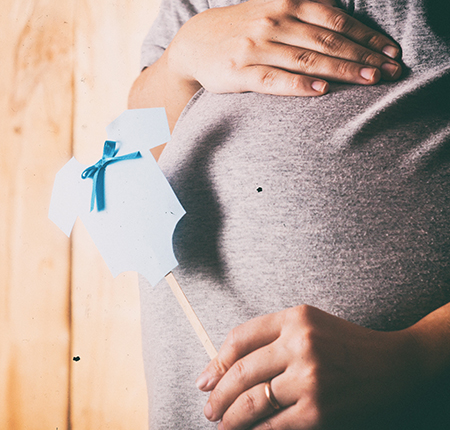
Pregnant belly in the last trimester
Starting at week 28, you enter the last stage of pregnancy, and the uterus is located just below the ribs. Weight gains will be at a slower rate and the baby has less and less room in the belly, which is why the pregnancy will put pressure on the bladder and lungs. Hence the more frequent need to urinate and fatigue. Here's what other changes occur before birth and how the baby grows in the last weeks:
At week 28, your baby is the size of a pumpkin and your belly can be slightly squished.
In weeks 29-31, the baby reaches the size of a pineapple and you will notice the Linea Nigra, that dark line on the belly that will disappear after birth.
In weeks 32-36, the pregnancy is still developing and the fetus is the size of a romaine lettuce.
In weeks 37-42, you will feel your belly getting heavier and heavier with more and more pressure. The baby will continue to grow to the size of a watermelon, and can come anytime after week 37.
After the birth you will start the postpartum period and lochia will appear, but you will hold your little one in your arms and you will be able to breastfeed him. As the body recovers, the belly will return to its pre-pregnancy shape and hormone levels will gradually return to normal balance






















